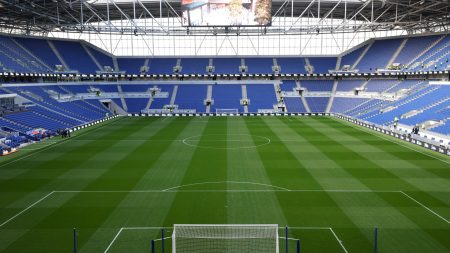The first half of the Arsenal vs. Newcastle match was a tense affair, characterized by missed opportunities and tactical adjustments from both sides. Arsenal, playing at their home ground, The Emirates, initially struggled to break down a well-organized Newcastle defense. Despite controlling possession for extended periods, the Gunners lacked the cutting edge in the final third, often misplacing passes or failing to connect with their forwards. A key moment early on highlighted their attacking struggles when Trossard overhit a pass intended for Havertz, squandering a potential scoring chance. This exemplified Arsenal’s frustration in trying to unlock the Newcastle backline. Newcastle, in turn, absorbed the pressure and looked to exploit counter-attacking opportunities, using their pace and physicality to create problems for the Arsenal defense. Their forward, Isak, proved to be a constant threat, showing impressive individual skill to beat Arsenal defenders but lacking support from his teammates to finish the created chances. The match’s early stages thus showcased a tactical battle between Arsenal’s possession-based approach and Newcastle’s counter-attacking strategy.
As the first half progressed, Arsenal began to exert more consistent pressure on the Newcastle defense. The Gunners increased the tempo of their passing and started to find more space in the attacking third. However, they continued to be plagued by inaccuracies in their final ball and a lack of clinical finishing. A prime example of this was Timber’s missed header from close range, a glaring opportunity that went begging. Despite their dominance in possession and the increasing number of attacks, Arsenal still found themselves unable to break the deadlock. Newcastle’s defense, anchored by the solid performance of Burn, remained resolute, effectively nullifying Arsenal’s attacking threats. Burn’s ability to read the game and intercept Arsenal’s intricate passes proved crucial in thwarting their attempts to penetrate the penalty area. The first half ultimately ended goalless, reflecting both Arsenal’s offensive struggles and Newcastle’s defensive resilience.
A significant tactical aspect of the first half was the role of Arsenal’s goalkeeper, Raya. Brought in for his supposed ball-playing abilities, Raya’s performance in this match contradicted that reputation. He made a costly error early on, gifting possession to Newcastle’s Livramento just outside the box. Fortunately for Arsenal, Newcastle failed to capitalize on this mistake, but the incident raised questions about Raya’s distribution and decision-making under pressure. This error highlighted a potential vulnerability in Arsenal’s build-up play and provided Newcastle with an unexpected opportunity. While Arsenal’s outfield players attempted to maintain possession and build from the back, Raya’s misplaced pass demonstrated the risks associated with this strategy.
Newcastle’s approach in the first half centered around a disciplined defensive structure and quick counter-attacks. They effectively limited Arsenal’s space in the midfield and prevented them from creating clear-cut chances. Isak’s pace and dribbling skills caused problems for the Arsenal defense, but his isolated runs often lacked support, preventing Newcastle from converting these opportunities into goals. Their counter-attacking strategy, while promising, lacked the final touch needed to truly threaten Arsenal’s goal. The large pitch at The Emirates, while potentially beneficial for Newcastle’s counter-attacking style, did not translate into any significant advantage in the first half. Despite the space available, their passing accuracy in the final third let them down, preventing them from effectively exploiting the wide areas of the pitch.
The first half of the match can be summarized as a tactical stalemate. Arsenal dominated possession and created more chances but lacked the finishing touch and precision in their passing. Newcastle, on the other hand, defended resolutely and looked dangerous on the counter but failed to capitalize on their limited opportunities and the occasional errors from Arsenal. The goalless scoreline reflected the balanced nature of the contest and set the stage for a potentially decisive second half. The key question remained whether Arsenal could find a way to break down Newcastle’s stubborn defense or if Newcastle could exploit Arsenal’s vulnerabilities and capitalize on their counter-attacking opportunities. The tactical battle between the two sides continued to unfold, with both teams searching for the breakthrough that would ultimately determine the outcome of the match.
The contrasting styles of play presented by both teams made for an intriguing first half. Arsenal’s focus on possession and intricate passing movements clashed with Newcastle’s more direct and physical approach. This tactical contrast provided a compelling dynamic to the game, with each team seeking to impose their style on the other. The large pitch at The Emirates, while theoretically favoring Arsenal’s possession-based game, also offered opportunities for Newcastle to exploit the space on the counter-attack. However, neither team fully capitalized on these potential advantages in the first half. The goalless scoreline at halftime underscored the evenly matched nature of the contest and set the stage for a potentially exciting second half. The tactical adjustments made by both managers in response to the first-half performance would likely prove crucial in determining the eventual outcome of the match.











